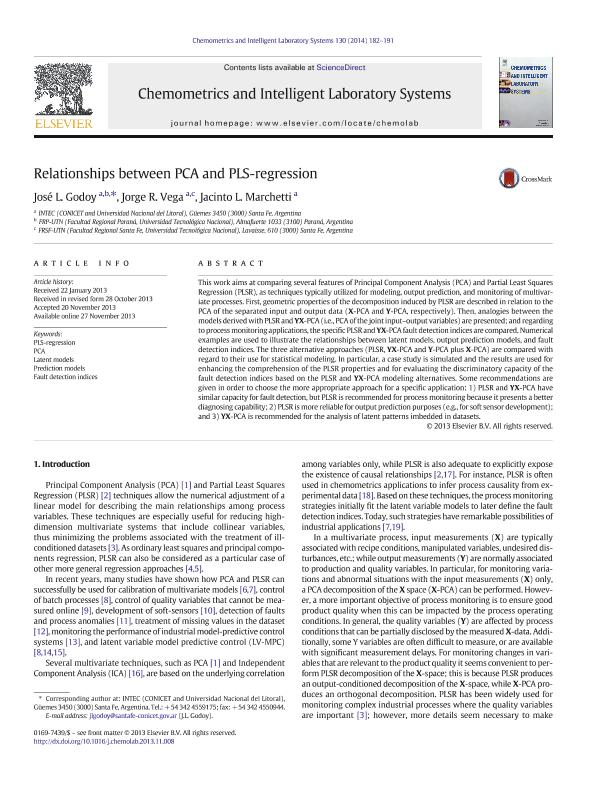Mostrar el registro sencillo del ítem
dc.contributor.author
Godoy, José Luis

dc.contributor.author
Vega, Jorge Ruben

dc.contributor.author
Marchetti, Jacinto Luis

dc.date.available
2016-12-13T19:12:24Z
dc.date.issued
2014-01
dc.identifier.citation
Godoy, José Luis; Vega, Jorge Ruben; Marchetti, Jacinto Luis; Relationships between PCA and PLS-regression; Elsevier Science; Chemometrics And Intelligent Laboratory Systems; 130; 1-2014; 182-191
dc.identifier.issn
0169-7439
dc.identifier.uri
http://hdl.handle.net/11336/9285
dc.description.abstract
This work aims at comparing several features of Principal Component Analysis (PCA) and Partial Least Squares Regression (PLSR), as techniques typically utilized for modeling, output prediction, and monitoring of multivariate processes. First, geometric properties of the decomposition induced by PLSR are described in relation to the PCA of the separated input and output data (X-PCA and Y-PCA, respectively). Then, analogies between the models derived with PLSR and YX-PCA (i.e., PCA of the joint input-output variables) are presented; and regarding to process monitoring applications, the specific PLSR and YX-PCA fault detection indices are compared. Numerical examples are used to illustrate the relationships between latent models, output predictive models, and fault detection indices. The three alternative approaches (PLSR, YX-PCA and Y-PCA plus X-PCA) are compared with regard to their use for statistical modeling. In particular, a case study is simulated and the results are used for enhancing the comprehension of the PLSR properties and for evaluating the discriminatory capacity of the fault detection indices based on the PLSR and YX-PCA modeling alternatives. Some recommendations are given in order to choose the more appropriate approach for a specific application: 1) PLSR and YX-PCA have similar capacity for fault detection, but PLSR is recommended for process monitoring because present a better diagnosing capability; 2) PLSR is more reliable for output prediction purposes (e.g., for soft sensor development); and 3) YX-PCA is recommended for the analysis of latent patterns imbedded in datasets.
dc.format
application/pdf
dc.language.iso
eng
dc.publisher
Elsevier Science

dc.rights
info:eu-repo/semantics/openAccess
dc.rights.uri
https://creativecommons.org/licenses/by-nc-nd/2.5/ar/
dc.subject
Pls-Regression
dc.subject
Pca
dc.subject
Latent Models
dc.subject
Prediction Models
dc.subject
Fault Detection Indices
dc.subject.classification
Otras Ingenierías y Tecnologías

dc.subject.classification
Otras Ingenierías y Tecnologías

dc.subject.classification
INGENIERÍAS Y TECNOLOGÍAS

dc.title
Relationships between PCA and PLS-regression
dc.type
info:eu-repo/semantics/article
dc.type
info:ar-repo/semantics/artículo
dc.type
info:eu-repo/semantics/publishedVersion
dc.date.updated
2016-12-12T13:44:41Z
dc.journal.volume
130
dc.journal.pagination
182-191
dc.journal.pais
Países Bajos

dc.journal.ciudad
Amsterdam
dc.description.fil
Fil: Godoy, José Luis. Consejo Nacional de Investigaciones Científicas y Técnicas. Centro Científico Tecnológico Santa Fe. Instituto de Desarrollo Tecnológico Para la Industria Química (i); Argentina. Universidad Tecnológica Nacional. Facultad Regional Paraná; Argentina
dc.description.fil
Fil: Vega, Jorge Ruben. Consejo Nacional de Investigaciones Científicas y Técnicas. Centro Científico Tecnológico Santa Fe. Instituto de Desarrollo Tecnológico Para la Industria Química (i); Argentina. Universidad Tecnologica Nacional; Argentina
dc.description.fil
Fil: Marchetti, Jacinto Luis. Consejo Nacional de Investigaciones Científicas y Técnicas. Centro Científico Tecnológico Santa Fe. Instituto de Desarrollo Tecnológico Para la Industria Química (i); Argentina
dc.journal.title
Chemometrics And Intelligent Laboratory Systems

dc.relation.alternativeid
info:eu-repo/semantics/altIdentifier/doi/http://dx.doi.org/10.1016/j.chemolab.2013.11.008
dc.relation.alternativeid
info:eu-repo/semantics/altIdentifier/url/http://www.sciencedirect.com/science/article/pii/S0169743913002189
Archivos asociados
